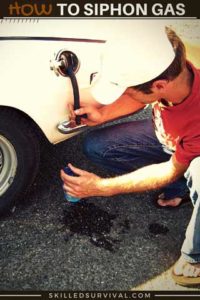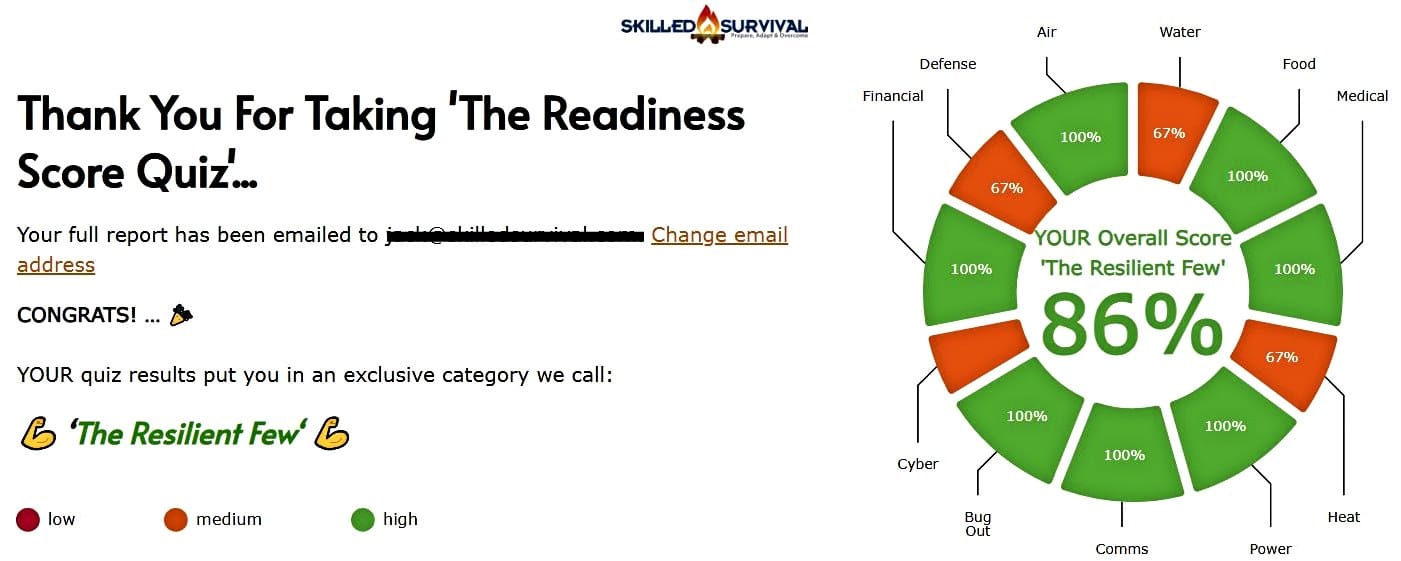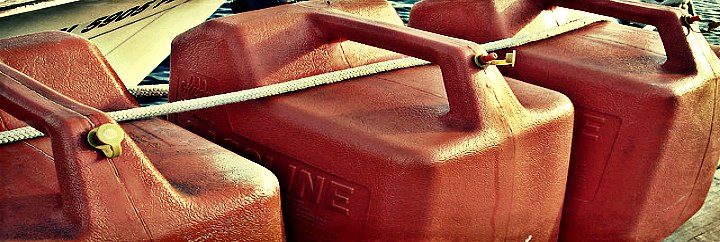
Because doesn’t matter WHO you are, WHERE you’re from, your age, or income level…
EVERYONE agrees:
Running out of gas sucks – BIG TIME!
It’s one of the most helpless feelings you can experience. And if running out of gas isn’t bad enough, running out in the middle of nowhere is worse.
And this is during normal times… What about in a widespread emergency?
Events when gas stations go dry. For these reasons, learning how to siphon gas just makes sense…
Quick Note: Don’t Use This Skill For Evil
When you need gas and theirs no station nearby, siphoning it from another vehicle is your best bet.
No, it won’t always be legal. But it’s a skill that could save your bacon in more ways than one. However, it’s NOT a skill most people can “figure out” on the fly.
It requires a bit of know-how and practice.
You need to understand basic fluid dynamics and have the right set of tools.
The good news is: Once you’ve done it a few times, it’s a skill you’ll never forget – like riding a bike. This is what this guide is for – it’s a “how-to” cheat sheet.
A quick and dirty guide with tips and tricks necessary to suck gas.
I only ask that you, the reader, use this guide for good instead of evil.
This is powerful knowledge. In the wrong hands, it can be used for sinister purposes… This is an excellent way of saying don’t siphon your friends’ and neighbors’ gas tanks just for fun.
Don’t be a cheap-ass who doesn’t pay for your own fuel during normal circumstances.
We call that “parasitic petty criminality” – and there’s no honor in it. That being said, let’s get down to the nitty-gritty business of siphoning fuel.

Want a free 54 item survival gear checklist?
Enter your email below to instantly download this Complete Checklist PDF. No purchase necessary. 👇 👇Best Gas Siphon Kits For Sale
Buying a gas siphoning kit is a great way to round off your vehicle’s emergency gear. Of course, you can always put together your own emergency gas siphoning kit.
Just go to the hardware store and purchase the necessary materials. But most of these commercial options come with either a hand pump or an electric pump.
These make siphoning gas a lot easier and a lot safer.
Flow Joe makes one of the most professional versions of the siphon kit.
This one costs more than most kits (which we'll cover shortly) but with that expense comes a lot of extra features.
For example, this gas tapper kit makes bypassing the anti-leak / anti-siphon technology a breeze.
Other less expensive kits don't provide any assistance in this department.
So you can think of this gas siphon kit as future-proof, as more and more cars have this technology.
And every year fewer "old" vehicles without it are lost.
So if you're serious about learning how to siphon gas today and in the future, this is a worthwhile investment.
Watch the following video to see how Gas Tapper easily gets around anti-siphon valves.
↓ Siphoning Gas With The GasTapper
Advertised as the largest gas siphon sold on American markets today.
This kit can siphon up to 4 gallons per minute!
At 8 feet in length this siphon comes with:
- an anti-kink spring, a universal hose clip
- a “jiggler” to get the siphon started
- a user’s manual.
This is a very basic kit but sometimes going simple is the way to go (K.I.S.S. - Keep It Simple Stupid).
It's just a clear hose with a simple pump valve on the end.
No bells, no whistles, no fuss.
How To Use:
- Before using, drain all liquid from the hose.
- The end of the tube must be lower than the pump before siphoning will start.
- Submerge pump into the liquid that is to be siphoned.
- Move the pump vigorously in an up and down motion. It is important the pump remain in the liquid at all times to start the siphoning. Once the flow starts, stop moving or shaking the pump as gravity will maintain the flow of the liquid. Once siphoning starts, keep the pump submerged in liquid.
- To stop siphoning, remove the pump from the liquid.
- Drain all liquid from the hose and clean thoroughly.
- Store in a cool, dry place.
↓ The Original Safety Siphon: RV Use

Want a free 54 item survival gear checklist?
Enter your email below to instantly download this Complete Checklist PDF. No purchase necessary. 👇 👇How To Siphon Gas (The Science Behind It)
Instead of droning about physics, it is way easier to watch the following short video. This video will give you a basic understanding of how and why siphoning works.
↓ The Siphon (Science Behind It)
3 Methods To Siphon Gas
There are various methods for siphoning gas. They all technically work, but some are more efficient, easier, and better for your health than others.
So, there are advantages and disadvantages to different methods.
We’ll cover the best (our most recommended) method first and our “last resort” method last.
Method 1: Using A Gas Siphon Pump (safest / easiest method)
For this method, you’ll need a siphon pump and a receptacle. There are several siphon pump options you can buy.
Some are affordable but basic, while others cost a few more dollars but have extremely helpful features.
Note: In the next section of this article, we highlight the best siphon pump kits money can buy. So make sure to check those out as well.
Step 1. Situate the receptacle on the ground below the gas tank.
Step 2. Insert both ends of the siphon pump tube into the gas tank and receptacle.
Check your siphon pump because many pumps come with specific ends – one for the tank and one for the receptacle.
If you do not get the right end in the right place, you will just blow air into the tank.
Step 3. Start pumping.
Siphon pumps come in lots of different shapes and styles.
Some are plungers; some are bulbs you squeeze with your hand. Regardless, once you start pumping, gas will start flowing.
Step. Stop pumping when you have the gasoline you need.
Now raise the end of the siphon above the gas tank to stop the flow and return any excess gas into the tank.
Here’s a video using a simple hand pump siphon – check out all the other siphon kit options we cover later in this article.
↓ Remove Gas The Easy Way
Side Note: Anti Siphon / Anti Leak Technology
Most newer cars are built with emergency anti-leak technology. This prevents fires in the event of a crash or rollover.
This is a nice feature in general, but it’s a pain in the butt when you need to siphon. There are ways around this, though.
Some anti-siphoning mechanisms can be bypassed using a screwdriver.
You can sometimes hold them open while you insert the tube into the tank. But you should be extremely cautious not to damage your vehicle’s fuel tank.
Other techniques require you to use a smaller tube for siphoning.
A smaller tube may subvert the ball lock or butterfly mechanism. This is doable but slows the process down immensely.
A 1-inch siphon tube can move approximately one gallon every two minutes. But, a ¼ inch tube does the same in eight minutes.
So as you can tell, some cars are also better for siphoning gas out of than others.
In general, older cars have less technology, so they will be easier to siphon.
Method 2. Add Air Pressure To The Tank
You’ll need two lengths of 1-inch diameter tubing (one long and one short), a gas receptacle, and a wet cloth.
Step 1. This method is a lot safer than mouth siphoning (covered next). Because it uses air pressure to force the gasoline out of the tank instead of your lung power.
First, feed the extended length of the tube into the gas tank until it’s submerged in gasoline.
Again, blow into it and listen for bubbles.
Step 2. Insert the smaller tube length into the gas tank alongside the long one.
Now use the cloth to seal the space around/between them.
In order to create a tight seal, it’s helpful to use a wet rag instead of a dry one.
Step 3. Place the receptacle on the ground (lower than the gas tank) and feed the other end of the long tube into it.
Step 4. Blow air into the short tube to increase the air pressure inside the tank.
Try to blow with your mouth, not your lungs, to minimize the risk of inhaling gasoline.
Step 5. Watch the longer tube for flow.
As you blow air into the tank, the pressure should force gasoline out of the other tube and into your receptacle.
Step 6. When you want to stop, remove the long end from your receptacle and place your thumb over the end to stop the flow.
Lift the tube above your head, release your thumb, and let gravity pull the remaining gas back into the tank.
↓ Easy Way To Siphon
Method 3: Mouth Siphoning (worst case / last resort)
The only tools you need are a length of 1-inch diameter clear tubing and a gas receptacle.
This is the old-school version of gas siphoning, and it is, by far, the worst method for you. Because it requires one to use their own mouth (instead of a pump) to draw the gasoline up and out of the tank.
The reason this is bad for you? Gas poisoning.
Gas poisoning is a real thing. It happens to people, and it’s not hard to do to yourself when you’re sucking gasoline out of a tank through a “straw.”
This method should be a last resort. You need to be extremely cautious not to swallow or inhale a bunch of gas in the process.
Step 1. Feed one end of the tube deep into the gas tank so it’s submerged in the gasoline.
To test this, blow into the tube – when you hear bubbles, you’re good to go.
Step 2. Place the gas receptacle (below the gas tank height) on the ground.
If the receptacle is above the tank, gravity won’t work on your side, and you won’t be able to get gas out of the car.
Step 3. Create suction by sucking on the end of the tube to draw the gasoline up and out of the tank.
Hold your hand just below the tip where you are sucking to crimp it when the gas comes up.
Note: This happens fast, so be alert and ready; you’ve been warned!
Suck on the tube with your mouth instead of your lungs (like smoking a cigar versus smoking a cigarette).
This helps to minimize the threat of inhaling gasoline.
Step 4. When the gas is six inches from where you are holding the tube, crimp it quickly to stop the gas flow.
Step 5. Place the end you were sucking on into the receptacle, let go of the crimp and let gravity do its thing.
Gas should flow out of the tank, through the tube, and into the receptacle.
Step 6 – Keep an eye out for bubbles in the tubing.
This is a major pain when siphoning gas, but it’s one that you will likely have to deal with.
If you see bubbles, the gravity flow is broken, and you’re about to lose your siphon.
Don’t try and suck the excess air out – you will inhale the gas.
Instead, drain the gas back into the car and try again until it works correctly.
Step 7. When you’ve reached the desired amount of gasoline in the receptacle, remove the end of the tube in the gas tank.
This will cut off the flow of gasoline.
Again, this is NOT a method I recommend.
Here’s an example of what can happen with this method:
↓ Bad Day Siphoning Gas (Accidental Mouthful)
**If you inhale or swallow gas, contact poison control immediately.
If you’re in the remote wilderness, this is not possible. Making this method potentially life-threatening – you’ve been warned!

Want a free 54 item survival gear checklist?
Enter your email below to instantly download this Complete Checklist PDF. No purchase necessary. 👇 👇When & Why You May Need To Siphon
Siphoning gas is a survival skill; however, it’s not exclusive to survival circumstances.
People siphon gas every single day in every state nationwide. And they do it for a multiplicity of reasons.
Reasons that run the gamut from innocent and innocuous to deranged and criminal.
Here are a few common ones:
Out Of Gas In The Middle Of Nowhere
This is the most common reason people siphon gas out of another vehicle.
Maybe you’re driving through a remote desert, hundreds of miles from any gas station. Or perhaps you’re rock crawling in the backcountry, and you run dry, sputtering to a stop on the side of the road.
What do you do? Well, wait…
Wait for another car to come along, flag them down, and then (if you know how to) politely ask to siphon.
Someone will be OK if you siphon off some of their gas.
We’re talking just enough to get you to the next gas pump.
I know I’d be OK with it in a survival circumstance like this.
I’d give them a hard time for not planning properly. But I wouldn’t leave them stranded.
Winterizing
If you are like me and you live in a place where it can get bitter cold in the dead of winter.
You should know how to siphon gas.
Some gasoline engines can act strangely in extremely cold conditions.
The gasoline doesn’t vaporize properly. And, believe it or not, gasoline can freeze in the most extreme cold temperatures!
That’s why siphoning is smart when storing a vehicle for harsh winters.
That’s because it’s wise to siphon out of the vehicles that will stay stored outside for any time.
Empty those puppies out so you can fill them and use them when needed.
This doesn’t just go for cars or trucks either; this is useful for lawnmowers stored in unheated sheds over the winter.
Lazy Refueling
Say your lawnmower, chainsaw, or even one of your cars runs out of gas, but you still have a full tank in another vehicle. Don’t make a trip back to the gas station to refuel.
Instead, siphon gas out a bit of the gas from the fuel tank you currently have access to.
Your full vehicle storage tank can be a backup gas canister if you know how to siphon.
Post-Apocalyptic Travel
In a mad-max post-apocalyptic wasteland, roadways will be littered with abandoned vehicles.
Many will still have some fuel left in the bottom of the tank.
If you are driving around this world gone mad and running low on fuel, siphon that liquid gold.
Fuel might be the most precious future resource man has ever known.
So store some extra fuel today and learn how to siphon gas for tomorrow.
↓ Mad Max 2: First Chase
Being A Petty Criminal
Sure, if you want to, you can go around under cover of darkness, siphoning gas out of other people’s cars.
All in the name of saving a few dollars. But that’s an a-hole move; don’t be an a-hole.
I suppose it’s technically a “reason,” but it’s not good. That’s why I hesitated even to add this “reason” to the list but felt obligated to do so or to be thorough.
Shame on you if you’re siphoning gas to save a few bucks.
Final Thoughts
Learning how to siphon is an essential survival skill.
Plus, it’s a useful skill for roadside emergencies. Not just for petty crime.
Every survivalist, outdoorsman, mechanic, and driver should learn how to do it. And if you want to be extra prepared, you should get a commercial siphon kit.

Prepare, Adapt & Overcome,
P.s. - I just found out 2 out of 3 Americans don’t feel prepared for a 3 day disaster!!!
I guess this goes to show how modern society continues to embrace ‘living a fragile life.’ What’s crazy is… it’s so easy to fix.
To make sure YOU have the basics, watch our FREE training on “10 Simple Steps To Basic Preparedness” that shows you HOW.
Nothing crazy here… this isn’t doomsday prepping... just the basics every responsible adult should have before a disaster strikes.Why You Can Trust Skilled Survival...
Go here now to review a full breakdown of:
- Who We Are
- Our Credentials
- Our Mission
- & Product Recommendations...
Here are a few highlights of our teams credentials & certifications:
- Certified Member of a Mountain Search & Rescue Organization
- Plant Emergency & Safety Leader for a Major Food Manufacturer
- Member of the 10TH Mountain Division Hut Association
- Certifications: Avalanche 1, WFR, CPR
- Official Gear Tester for Numerous Outdoor Gear Companies
- Countless Multiday Backpacking trips into Remote Wilderness
- Bachelor's Degree In Mechanical Engineering
- Bachelor's Degree In Civil Engineering
- Bachelor's Degree In Biomedical Engineering
"It takes 20 years to build a reputation and five minutes to ruin it." - Warren Buffett
We're fully aware that trust is NOT something you GET but is EARNED.
And we'll continue to earn YOUR trust through our forthright and honest approach with each new Blog Post, Guide & Product we create...
P.s - I just took this FREE 60-second 'Readiness Score Quiz'👇
AND... I've still got a few gaps in my preps...🤔 But at least, I'm not part of 'The Fragile Masses'. 👍 Find out where YOU stand by answering a few questions...

Recommended Reading
Survival Pack: How To Build One NOW (before SHTF)
A complete list of critical items that need to be in your survival pack before heading out into the wilderness.
Survival Packing List: Best For An Evacuation
Everyone needs a survival packing list to organize their escape. That way you won't regret leaving something critical behind.
Wild Edible Plants: The 13 Best Ones ANYONE Can Find
Discover the best wild edible plants you can find and eat nearly anywere. Knowing and identifying these wild edibles could save your life.
How To Make Catfish Bait: My Grandpa’s Ultimate Recipe
I want to share with you what I consider the best catfish bait recipe. Here's how to make stink bait that will get the catfish to bite.
Paracord Projects: 17 Useful Survival Tools You Can Make Today
I share the best paracord projects that are both fun and useful. By doing these crafts you'll always have lifesaving cordage on hand.
Survival Skills: The Ones Everyone Should Master
The best survival skills will keep you alive even in extreme conditions. 1. Water 2. Shelters 3. Fire 4. Navigation 5. Signaling 6. Medical







